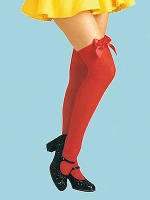
I admit it. I have been asked this question many, many times, "Who invented pantyhose?" and I am happy to be able to post the following answer as to who invented pantyhose, which comes to us courtesy of the USPTO and Glen Raven Mill.
Allen Gant Senior invented pantyhose. In 1959, Glen Raven Mills of North Carolina introduced pantyhose -- underpants and stockings all in one garment. With the addition of an opaque nylon top, panthose eliminated the need for multiple "foundation" garments. In 1965, Glen Raven Mills developed a seamless pantyhose version that coincided with the introduction of the miniskirt. Allen Grant Senior is a descendant of John Gant, who founded the textile mill in 1902.
Pantyhose and Nylons - Background History
In 1930, Wallace Hume Carothers, Julian Hill, and other researchers for the DuPont Company studied chains of molecules called polymers, in an attempt to find a substitute for silk. Pulling a heated rod from a beaker containing carbon-and alcohol-based molecules, they found the mixture stretched and, at room temperature, had a silky texture. This work culminated in the production of nylon marking the beginning of a new era in synthetic fibers.
Nylon was first used for fishing line, surgical sutures, and toothbrush bristles. DuPont touted its new fiber as being "as strong as steel, as fine as a spider’s web," and first announced and demonstrated nylon and nylon stockings to the American public at the 1939 New York World’s Fair. To be exact, on October 27, 1938, Charles Stine, vice president of E. I. du Pont de Nemours, Inc., announced that nylon had been invented. According to The Nylon Drama by authors David A. Hounshell and John Kenly Smith, Jr., "He unveiled the world's first synthetic fiber not to a scientific society but to three thousand women's club members gathered at the site of the 1939 New York World's Fair for the New York Herald Tribune's Eighth Annual Forum on Current Problems. He spoke in a session entitled 'We Enter the World of Tomorrow' which was keyed to the theme of the forthcoming fair, the World of Tomorrow."
According to Dupont Heritage:"Nylon emerged from research on polymers, very large molecules with repeating chemical structures, that Dr. Wallace Carothers and his colleagues conducted in the early 1930s at DuPont’s Experimental Station. In April 1930, a lab assistant working with esters – compounds which yield an acid and an alcohol or phenol in reaction with water – discovered a very strong polymer that could be drawn into a fiber. This polyester fiber had a low melting point, however. Carothers changed course and began working with amides, which were derived from ammonia. In 1935, Carothers found a strong polyamide fiber that stood up well to both heat and solvents. He evaluated more than 100 different polyamides before choosing one [nylon] for development."
DuPont built the first full-scale nylon plant in Seaford, Delaware, and began commercial production in late 1939. The company decided not to register nylon as a trademark, according to Dupont they, "choose to allow the word to enter the American vocabulary as a synonym for stockings, and from the time it went on sale to the general public in May 1940, nylon hosiery was a huge success: women lined up at stores across the country to obtain the precious goods."The first year on the market, DuPont sold 64 million pairs of stockings. That same year, nylon appeared in the movie, The Wizard of Oz, where it was used to create the tornado that carried Dorothy to the Emerald City.
In 1942, nylon went to war in the form of parachutes and tents. Nylon stockings were the favorite gift of American soldiers to impress British women. Nylon stockings were scarce in America until the end of World War II, but then returned with a vengeance. Shoppers crowded stores, and one San Francisco store was forced to halt stocking sales when it was mobbed by 10,000 anxious shoppers.
Julie Newmar, a living Hollywood film and television legend is an inventor in her own right. The former Cat Woman patented ultra-sheer, ultra-snug pantyhose. Known for her work in films such as Seven Brides for Seven Brothers and Slaves of Babylon, Newmar has also appeared recently in Fox Television’s Melrose Place and the hit feature-film "To Wong Fu, Thanks for Everything, Love Julie Newmar."
Today, nylon is still used in all types of apparel and is the second most used synthetic fiber in the United States.

No comments:
Post a Comment